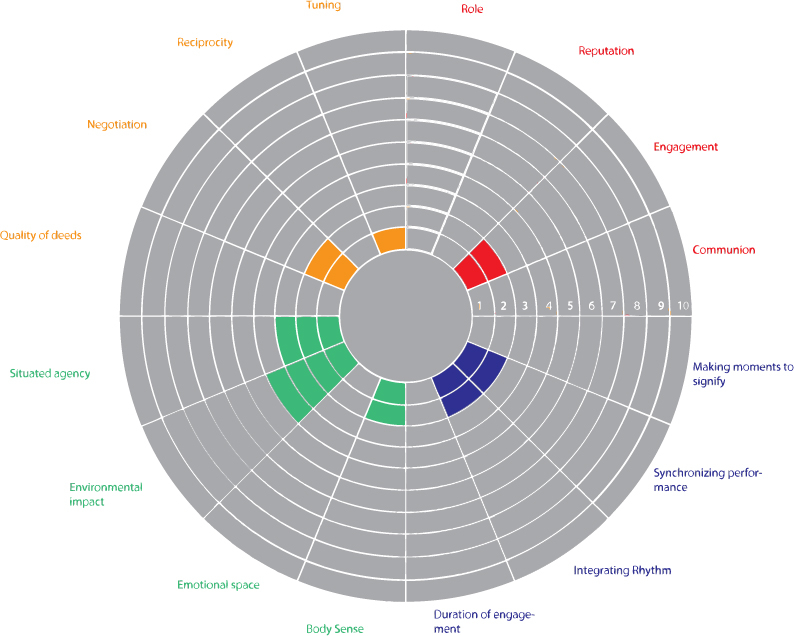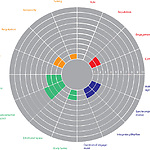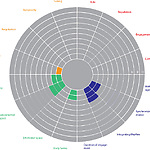2.4. Comparisment and conclusion
The four YUTPA analyses have been completed. The differences between the current and the future situation for both the local homeowner and the tourist will be compared, which will eventually lead to a conclusion. A new graph is made showing the difference in all the segments that scored higher than 5 and are seen an important. The difference between the local homeowner and the tourist is also discussed, but not visualized.
To begin with, the design challenge of chapter 1 viewed on Texel as becoming an independent energy user and supplier and elaborated on how this will impact the accommodations for locals and tourist. Besides this the degree of monitoring of existing and potential impacts is discussed for tourism, along with efficient management, to allow corrective or preventive measures. This all done keeping in mind the high dependency of Texel from tourism. Furthermore, there is discussed that accommodations will impact the environment and that the aspects of frequently changing behaviours in food consumption, energy and water usage impact accommodation a lot. To accommodate community, it will result in a highly interesting design challenge to react to these seasonal changes.
Difference tourist accommodation current & future - Main target Integrating rhythm and Environmental impact
As we can see from the graph above, not only the environmental impact will grow, but also the integration of rhythm. This follows from the next step which is more focussed on finding possible directions to design for in the sense of equally spreading out tourism and creating even higher involvement of locals into the accommodating the whole community. There is expected that tourism will grow and fluctuates less when Texel will become a sustainable island. Also the change in the tourist target group will result in a higher involvement of tourists. It is important to note that, even though tourist will visit the island more spread out over the year, their daily or weekly rhythm is of high importance as a design tool.
Local homeowners seem to change more in the relation and action segments of the YUTPA analyses. This is probably due to the longer duration of their involvement. This means changes need to be made to work towards a sustainable island that is able to accommodate community the right way. To start with, the focus should not merely be on creating energy sustainable housing but social aspects should definitely play a bigger role. The acceptance of locals, camping owners and even tourists is of such an importance that the whole direction of creating a sustainable community is very dependent on this acceptance. As for now the community is viewed upon separate groups that do not share the same interests and live completely different lives on Texel. To create higher involvement in the sustainable island, all the groups should live side by side and share each other’s experiences of Texel. This will result into higher involvement and for tourism might it even lead to bonding with the island, therefore returning possibly more often. The graph below shows situated agency will grow over time, meaning the local homeowners want to gain more ways to act on a certain situation. Even though the island functions on tourism, the locals should always stay in control of this tourism. A government could support them following in various pathways to change tourism, such as a less fluctuating tourism or a more social tourism, but it shouldn’t take the matter into it’s own hands.
Difference private accomodation current & future - Main target Environmental impact and Situated agency
To put this in more concrete actions, applying a more fluent tourism with an integrated rhythm should be exploited. One of the strong points, which is also one of the difficulties, is the strong connection between the residents of the small community. These values can contribute to the sustainable island by extending the community in such an extent that accommodation makes it that tourists will become more part of the total community. Tourist housing should be able to be repositioned and flexible, to follow the same rhythm which is highly dynamic. Therefore, housing should be able to repositioned and especially during low season be better integrated with the local housing. It should be stimulated to let local islanders share their experiences and be a proud enthusiastic islander by sharing their innovative views on sustainability. Therefore, commitment in general and social control should be further exploited. At the same time, the situated agency of the locals should be taken into account, letting locals keep the control over tourism. By taking all of this into account, a proper design context can be formed.


